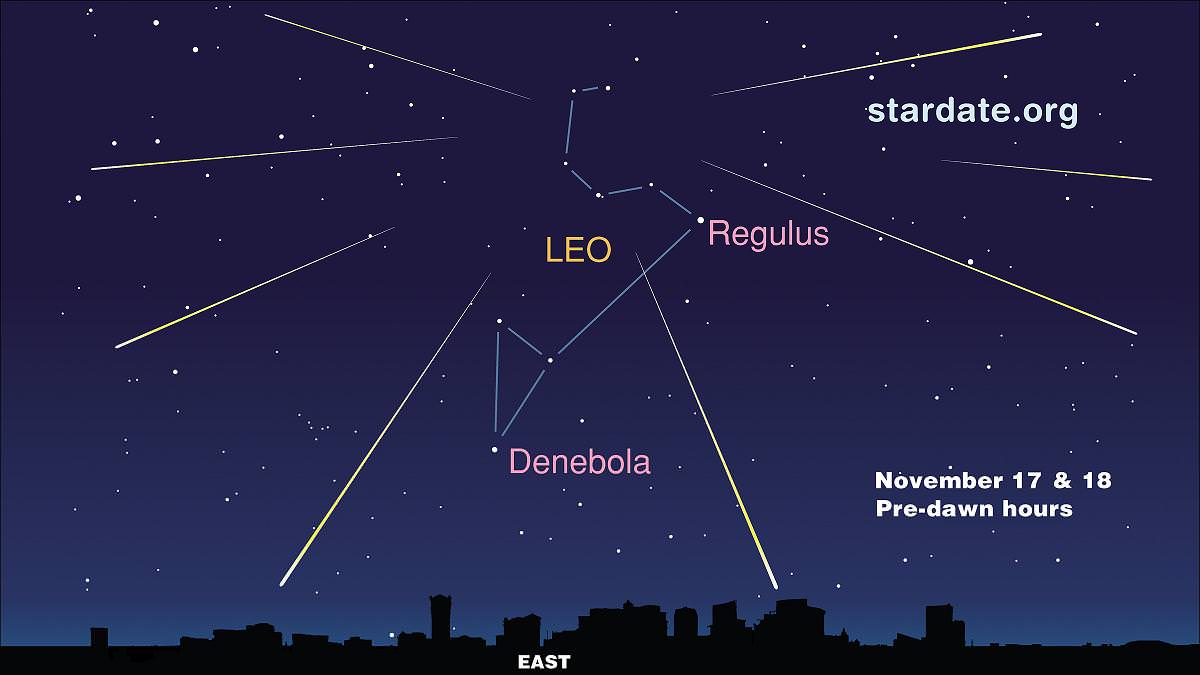Are you ready to walk into the lion’s cage? Then break out your favorite skywatching gear because the 2010 Leonid meteor shower is underway…
In the pre-dawn hours on the mornings of November 17 and November 18, the offspring of Comet Temple/Tuttle will be flashing through our atmosphere and just taunting you to test your meteor watching skills against bright skies. Although the phat Moon will greatly interfere with fainter meteor trails, don’t let that stop you from enjoying your monring coffee with the sparkling “cubs” that will be shooting out from the constellation of Leo.
Where? For all observers the constellation of Leo is along the ecliptic plane and will be near its peak height during best viewing times. When? Because of the Moon, just a couple of hours before local dawn is the best time to watch. Why? Read on!
Although it has been a couple of years since Temple/Tuttle was at perihelion, don’t forget that meteor showers are wonderfully unpredictable and the Leonids are sure to please with fall rate of around 20 (average) per hour. Who knows what surprises it may bring! Each time the comet swings around our Sun it loses some of its material in the debris trail. Of course, we all know that is the source of a meteor shower, but what we don’t know is just how much debris was shed and where it may lay.
As our Earth passes through the dusty matter, it may encounter a place where the comet let loose with a large amount of its payload – or it may pass through an area where the “comet stuff” is thin. We might even pass through an area which produces an exciting “meteor storm” like the Leonids produced in 1883! For those in the know, the Leonid meteor shower also made a rather incredible appearance in 1866 and 1867 – dumping up to 1000 (not a typo, folks) shooting stars recorded even with a Moon present! It erupted again in 1966 and in 1998 and produced 3000 (yep. 3000!) video recorded meteors during the years of 2001 and 2002. But remember, human eyes may only be able to detect just a few…
And I ain’t lion!
Photo Courtesy of Stardate.org, Texas University


Hi Tammy, what is the predication for peak in Universal Time? Cheers in advance.
Spoodle58 – From what I’ve seen, the traditional peak for this years’ shower should occur 17 Nov at 21:15 UT (from the International Meteor Organization). But theoretical work predicts the peak may occur earlier on the 17th, at 15:00 UT. Many details and links here: http://www.arm.ac.uk/leonid/
More info from the IMO: http://www.imo.net/calendar/2010#leo
Plan accordingly…..and clear skies!
Yippee! The Leonids are ‘my’ meteor shower… my B-day! That makes me a Valentine’s Day baby? Leonids move at 156,000 miles per hour or 43.3 miles per second – they are the fastest of all meteors…. bolides are not uncommon in this shower. On Nov. 12, 1833 a fantastic Leonid Meteor storm changed a lot of people’s religions! An ‘early’ date for the shower? Orbital processing with Jupiter to blame? The Leonids are also known as “The Tears of St. Lawrence”, a Christian deacon who was cooked by the Roman’s in an outdoor stove. The Chinese first noted it in 36 AD
There will never be another storm like that one in 1833 from the Leonids? But then again, in 2001 we counted +1,000/hour! I WOULD LOVE TO SEE THAT AGAIN! or hear it! During the peak of the 2001 storm, odd sounds were heard coming from a new blue plastic tarp laid out on the asphalt by one of the observers. It was really DRY and cold out… The plastic became an electro conductive speaker of sorts? AWESOME!
The night of the 2001 shower, I had my parka on and laid down in the middle of a street in the tiny town of Wells BC (no traffic, cold, dark skies, and at least one dog walker who hadn’t looked up thinking I was nuts).
I forget how long I was out, probably 1.5 hours or so before I got too cold. I counted over 1000. Was a great night.
AQUA
WRT2U The Tears of St Lawrence refer to the Perseids rather than the Leonids – sorry.
See David Levy’s Guide to observing Meteor Showers for example.
@ Jon Hanford,
Thanks for that info, much appreciated. Hope you get clear skies.
Its not looking good here unfortunately, but I hope for a break with all the rain we had that would give me crystal clear skies.
@ Aqua 2001 was awesome, we didn’t get big numbers here but we got some big bangs. 🙂